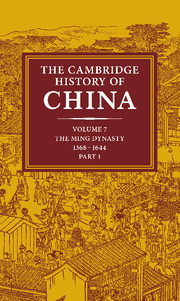Book contents
- Frontmatter
- Introduction
- 1 The rise of the Ming dynasty, 1330–1367
- 2 Military Origins of Ming China
- 3 The Hung-wu reign, 1368–1398
- 4 The Chien-wen, Yung-lo, Hung-hsi, and Hsüan-te reigns, 1399–1435
- 5 The Cheng-t'ung, Ching-t'ai, and T'len-shun reigns, 1436–1464
- 6 The Ch'eng-hua and Hung-chih reigns, 1465–1505
- 7 The Cheng-te reign, 1506–1521
- 8 The Chia-ching reign, 1522–1566
- 9 The Lung-ch'ing and Wan-li reigns, 1567–1620
- 10 The T'ai-ch'ang, T'ien-ch'i, and Ch'ung-chen reigns, 1620–1644
- 11 The Southern Ming, 1644–1662
- 12 Historical writing during the Ming
- Bibliographic notes
- Bibliography
- Glossary-index
Introduction
Published online by Cambridge University Press: 28 March 2008
- Frontmatter
- Introduction
- 1 The rise of the Ming dynasty, 1330–1367
- 2 Military Origins of Ming China
- 3 The Hung-wu reign, 1368–1398
- 4 The Chien-wen, Yung-lo, Hung-hsi, and Hsüan-te reigns, 1399–1435
- 5 The Cheng-t'ung, Ching-t'ai, and T'len-shun reigns, 1436–1464
- 6 The Ch'eng-hua and Hung-chih reigns, 1465–1505
- 7 The Cheng-te reign, 1506–1521
- 8 The Chia-ching reign, 1522–1566
- 9 The Lung-ch'ing and Wan-li reigns, 1567–1620
- 10 The T'ai-ch'ang, T'ien-ch'i, and Ch'ung-chen reigns, 1620–1644
- 11 The Southern Ming, 1644–1662
- 12 Historical writing during the Ming
- Bibliographic notes
- Bibliography
- Glossary-index
Summary
This volume and the following volume are devoted to the history of the Ming dynasty. The present volume offers a narrative account of political developments from the rebellions of the mid-fourteenth century that ended the Mongol Yuan dynasty's control over China –and from one of which the new Ming dynasty was formed in 1368 –until the last Ming remnant, called the Southern Ming, was extinguished in Burma in 1662. That was almost twenty years after the new Manchu Ch'ing dynasty had proclaimed the success of its conquest of the Mandate of Heaven, and of China, in Peking in the spring of 1644.
That period of roughly three centuries from the 1340s until the 1660s, or more closely defined, the 277 years from 1368 until 1644 during which Ming rule formally prevailed, is the only segment of later imperial history from the fall of the Northern Sung capital to the Jurchen invaders in 1126 until the Revolution of 1911 ended the imperial era during which all of China proper was ruled by a native or Han Chinese dynasty. The actual impact of that alternation of native and conquest dynasties on Chinese life was, to be sure, of varying significance, and at its most destructive it probably never threatened to interrupt the cultural continuity of Chinese development. Nonetheless, the success of the Chinese in regaining control over their own government is an important event in history.
In Ming times and even more so in the recent nationalistic-minded century, the Ming dynasty has been seen as an important era of Chinese resurgence.
- Type
- Chapter
- Information
- The Cambridge History of China , pp. 1 - 10Publisher: Cambridge University PressPrint publication year: 1988
- 1
- Cited by

